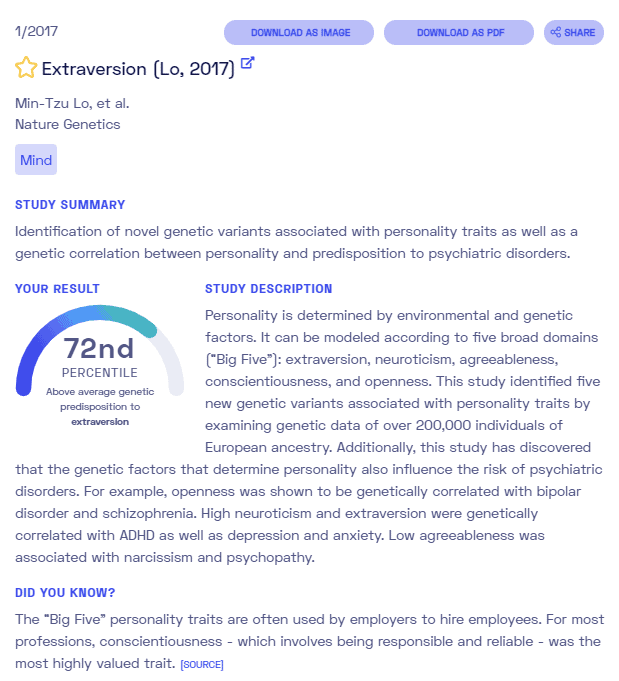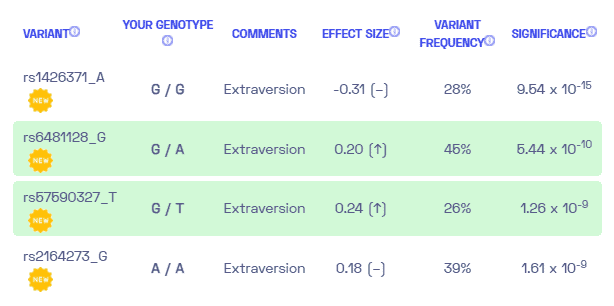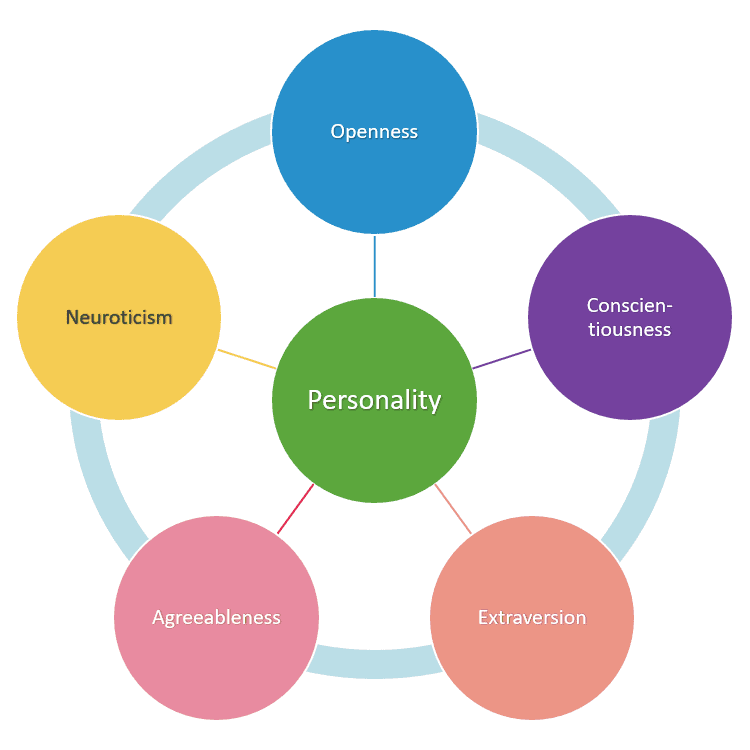Table of contents
Nebula Genomics DNA Report for Personality
Is personality genetic? We created a DNA report based on a study that attempted to answer this question. Below you can see a SAMPLE DNA report. To get your personalized DNA report, purchase our Whole Genome Sequencing!


People often describe the amount of human personality controlled by genes with the question: “Nature or Nurture?” The core of this question is whether a person’s genes or environmental influences predetermine it.
How do nature and nurture influence human behavior? In almost all cases, experts agree that it is a combination of both. However, experts continue to debate as to how much each contributes.

What is Personality?
An individual’s personality is extremely complex and generally considered as a combination of various traits. Others may think of it as how friendly a person is. The American Psychological Association defines it as differences in characteristic patterns of thinking, feeling and behaving.
Is Personality Genetic?
Psychological science has spent decades on the study of personality and genetic factors. One of these studies was the Minnesota Study of Twins Reared Apart, which looked at 350 pairs of identical and fraternal twins between 1979 and 1999.
In this twin and adoption study, the results suggest that family twins share behavioral traits whether they are raised together or apart, supporting the idea that some parts of temperament traits are genetic. The study estimated that their immediate environment influences as much as 80% of their temperament.

Another twin personality testing involving 250 pairs of twins (123 identical and 127 fraternal) suggests heritability estimates of 40-60%. The single study published in 1996 estimated the percentage of each of the five personalities determined by genetics as follows:
- Conscientiousness – 44%
- Agreeableness – 41%
- Neuroticism – 41%
- Openness to experience – 61%
- Extraversion – 53%
Experts believe many of the specific genes that play a role in personality are involved with communication between cells and the brain. MedLine Plus cites a number of genetic variants:
- DRD2 and DRD4: Enhances the desire to seek out new experiences
- KATNAL2: Associated with self-discipline
- PCDH15 and WSCD2: Associated with sociability
- MAOA: Introversion
You can read more about current research in The Journal of Personality and Social Psychology.
Current Research
Before the development of behavior genetics research and biometrics, as we know it today, psychologists like Raymond Cattell (1905-1998) became prolific with their proposals and trait theories on human development and how the environment and culture influence it.
As mentioned earlier, research shows there may be certain genetic mechanisms involved, from an article explaining the evolutionary genetics of personality in 2007 to the more in-depth analyses of the role of genes.
A particular study from 2014 takes a deeper look at how genes and environment influence personality development. The paper tries to figure out the factors influencing how mentally stable we grow as we get older.
Scientists and experts have invested a significant amount of time shedding light on disorders and the genetic influence of nurture and nature. For example, psychologists and mental health professionals use the Minnesota multiphasic personality inventory to assess psychopathologies. The book “Toward the Dark Side: Temperament, Personality, and Genetics Related to Antisocial Behaviors” explores the concept in detail.
This abstract reviews molecular genetics in psychology and personality neuroscience. According to the publication, the precise genetic foundation of hereditability of psychological traits remains elusive.
Scholars have published a long list of research and literature on the molecular genetics of psychological traits. The journal Neuroscience & Behavioral Reviews, published in November 2020, reviews these pieces of literature. Check out the highlights on the scope and description of the study. The authors also provide ideas on how to proceed with genome-wide association studies (GWAS) reports.
Personality Disorders
These disorders are a type of mental illness involving long-term patterns of predominantly random thoughts and behaviors, often leading to mental health problems, including difficulty in functioning in daily life and maintaining relationships. These disorders include difficulty in relating to other people and situations.
Disorders usually start during the teenage or early adult years and can be difficult to diagnose. However, they may become less noticeable as adults mature and learn to live with them.
There are many types and people may exhibit symptoms of one or more. They can be classified as eccentric (paranoid or schizophrenia), dramatic (antisocial, borderline, histrionic, and narcissistic), or fearful (anxiety or obsessive compulsive disorder).
The Big Five Model
The aspects of personalities are diverse. Many experts rely on the big five personality traits to define an individual’s overall temperament. According to this theory, traits are on a spectrum, meaning that a person can fall from low to high on each and anywhere in between.
However, they tend to remain stable throughout someone’s life. Studies suggest both genetic and environmental factors shape our personality, with an estimated heritability of 50%, according to this article in SimplyPsycology.
Agreeableness: how a person treats relationships with others. People with high agreeableness tend to show trust, altruism, kindness, and affection towards others.
Conscientiousness: ability to engage with thoughtfulness, good impulse control, and goal-directed behaviors. People with high conscientiousness appear focused and organized.

Extroversion: The extent to which someone seeks out relationships with their environment and with other people. Extroverts tend to appear friendly, outgoing, and talkative. The opposite of extroverts are introverts – people who prefer to listen and appear more reserved or quiet in social settings. This is one of the major focuses of the Myers-Briggs type testing.
Neuroticism: The overall emotional stability of an individual. It includes how likely a person sees events as threatening or difficult. People with high neuroticism can be anxious and moody.
Openness: Willingness to try new things and engage in imaginative or intellectual activities. People with high openness tend to be more creative and artistic while those with low openness are more comfortable in routine.
Other approaches
A person usually describes themselves as shy, sociable, or organized, or fitting under one or more of these traits. Scientists have found that these traits may evolve slightly from childhood to adulthood but, for the most part, stay stable throughout a lifetime.
Other popular approaches to the personality dimension include:
Humanistic perspective: Temperament is based on psychological growth, free will, and personal awareness. Carl Rogers suggests that people are inherently good and that free will drives most personality types.
Another theorist on this perspective, Abraham Maslow, suggested that people are motivated by a hierarchy of needs. People focus their energy on the necessary components of life first (e.g. food, water), and once those are met, their personality characteristics become more focused on things like esteem.
Psychoanalytic perspective: This theory focuses on early childhood experiences and the unconscious mind. Sigmund Freud is one of the most well known theorists of this perspective. Neo-Freudian theorists, including Erik Erikson and Carl Jung, built upon Freud’s ideas to create their theories of personality.
Summary
Overall, it is largely understood that an individual’s experience is a combination of genetic components and environmental factors. The Big Five model provides a good overview of some of the most common traits that come together to form an overall temperament.
Research suggests that anywhere between 20-60% results from heredity. This has been shown through detection of similar types of personality in twins who were raised in different environments. An unclear inheritance pattern suggests that this characteristic results from a complex interaction of many genes.
If you liked this article, you should check out our other posts in the Nebula Research Library!
June 20, 2023
